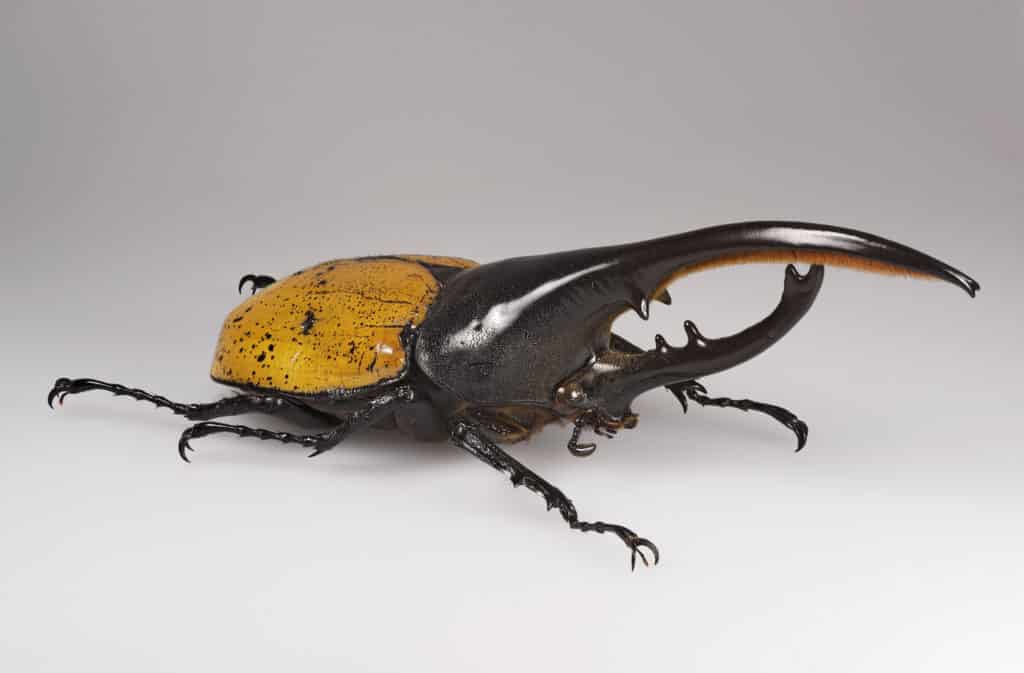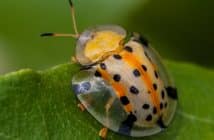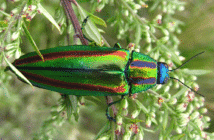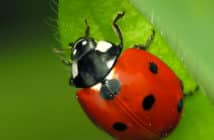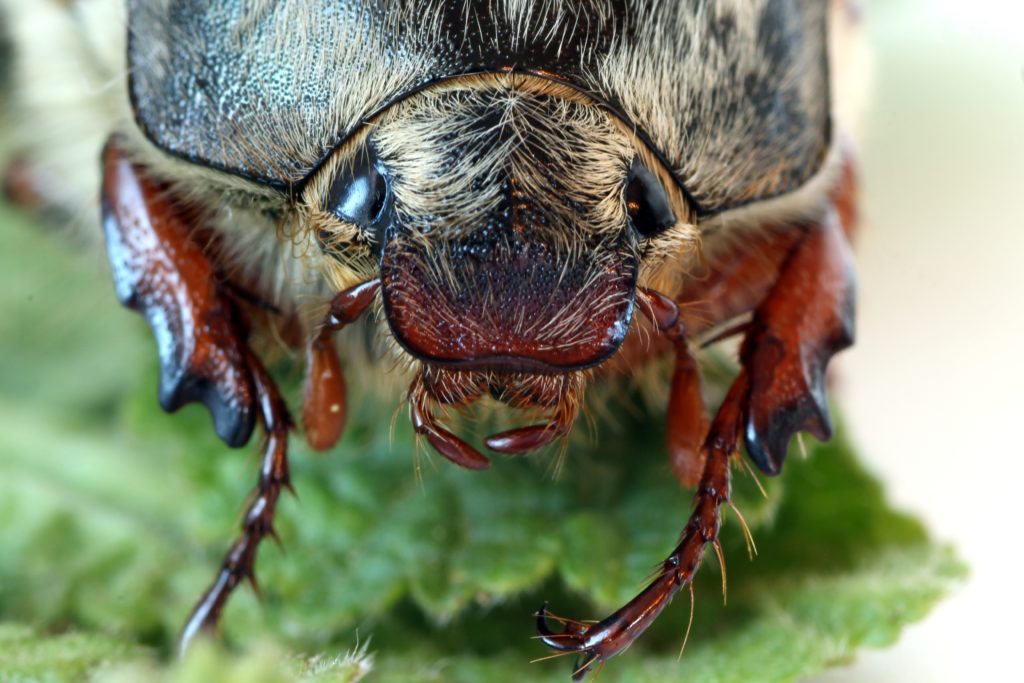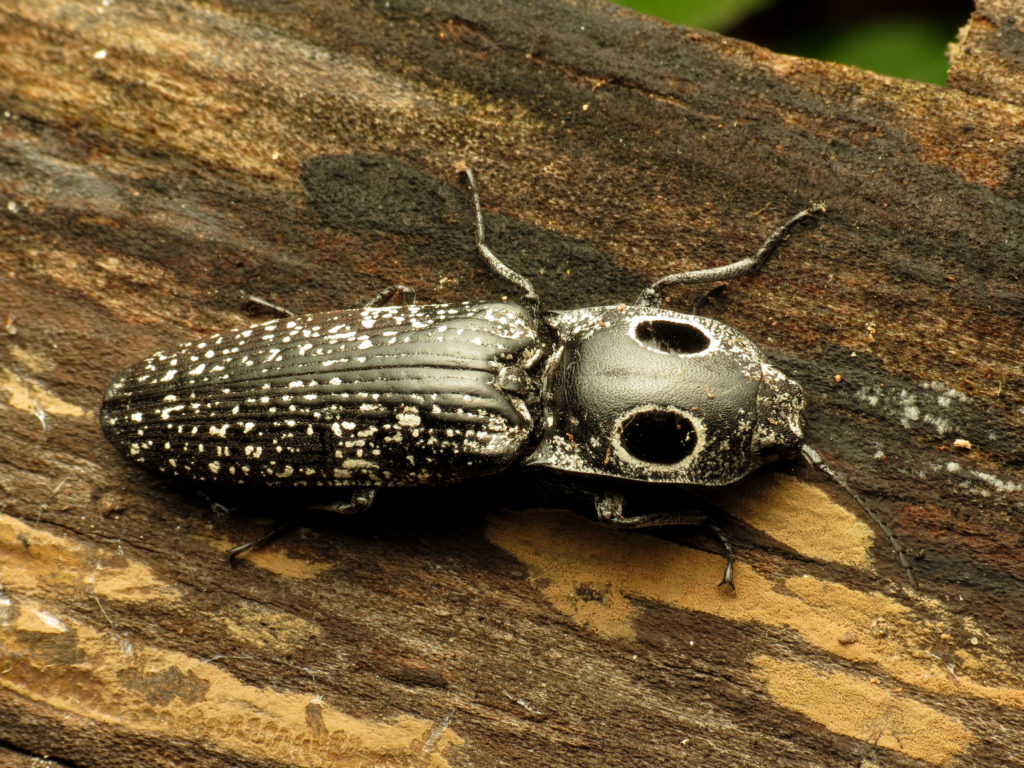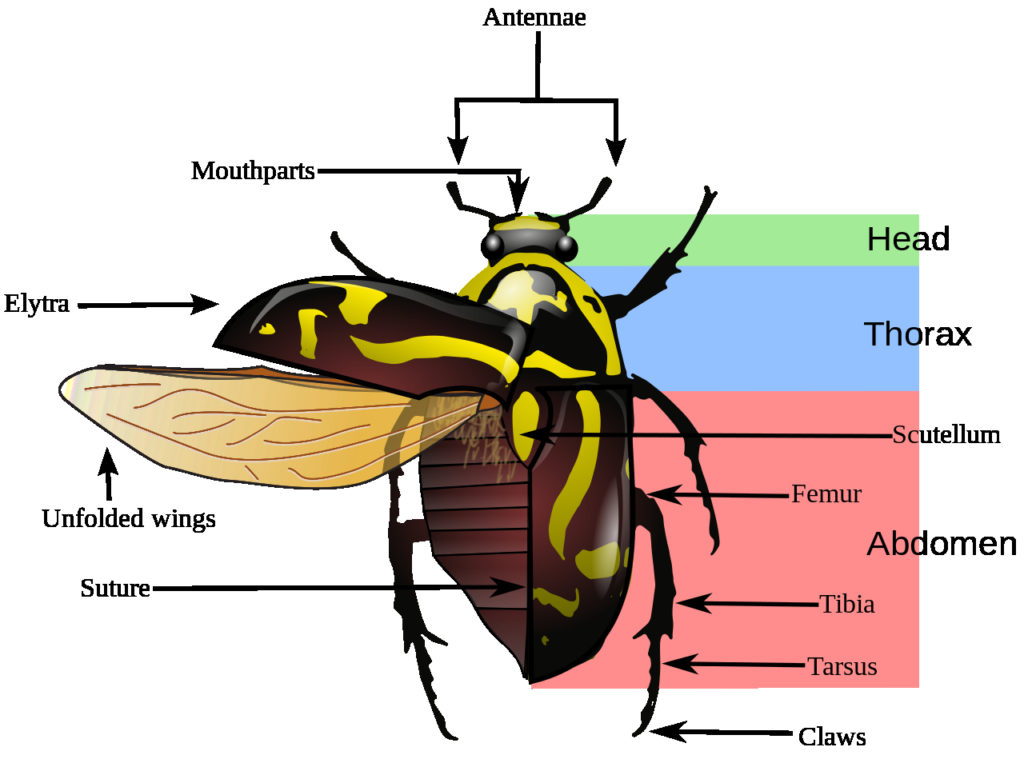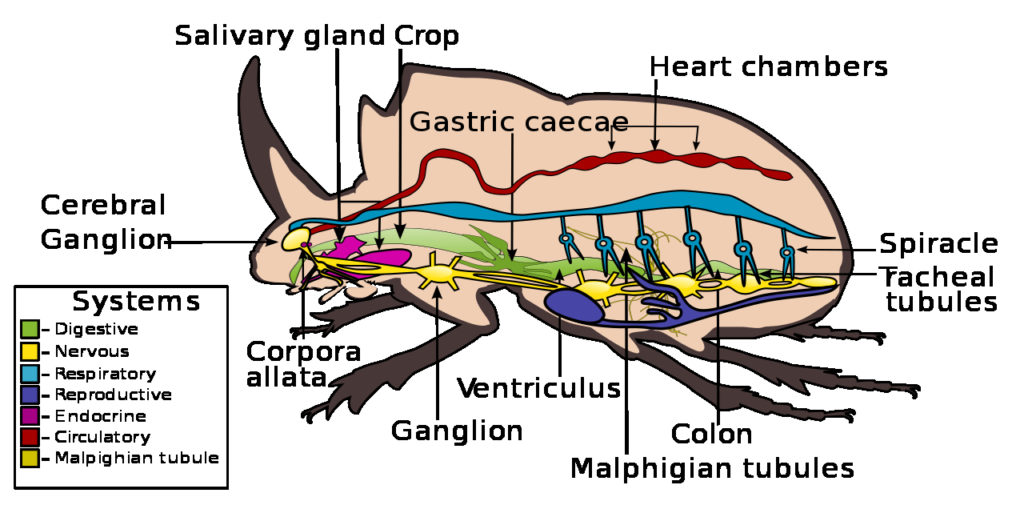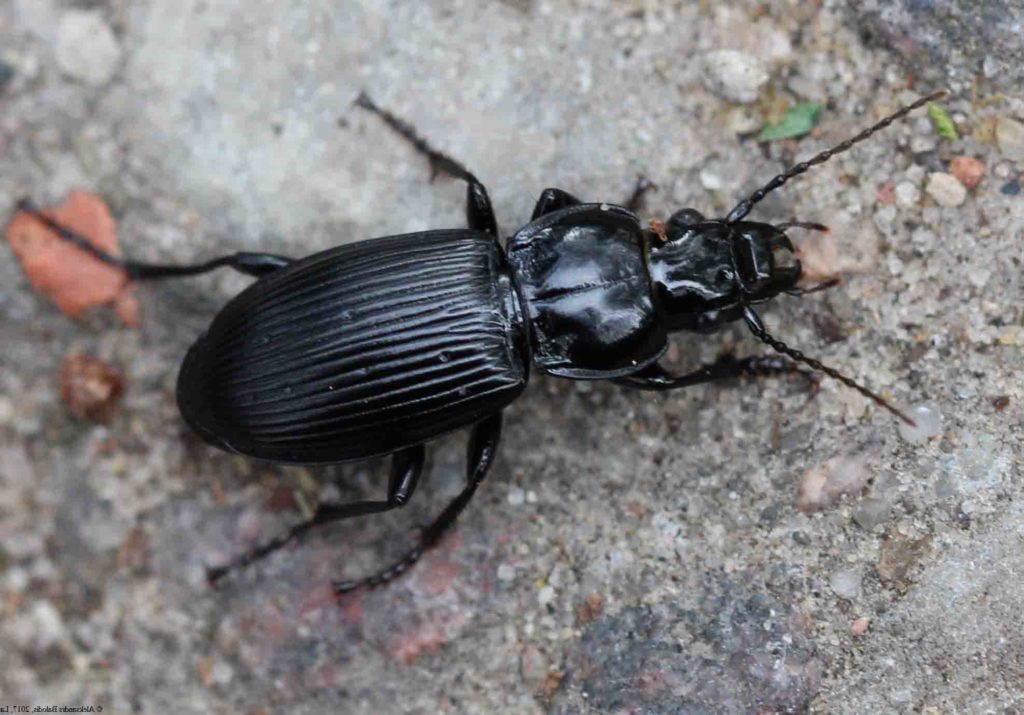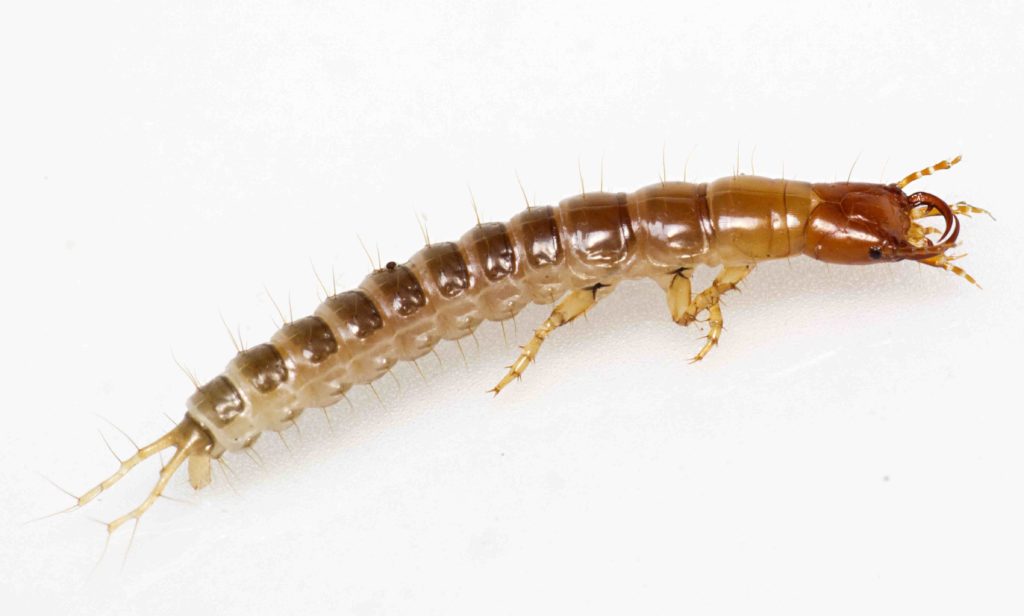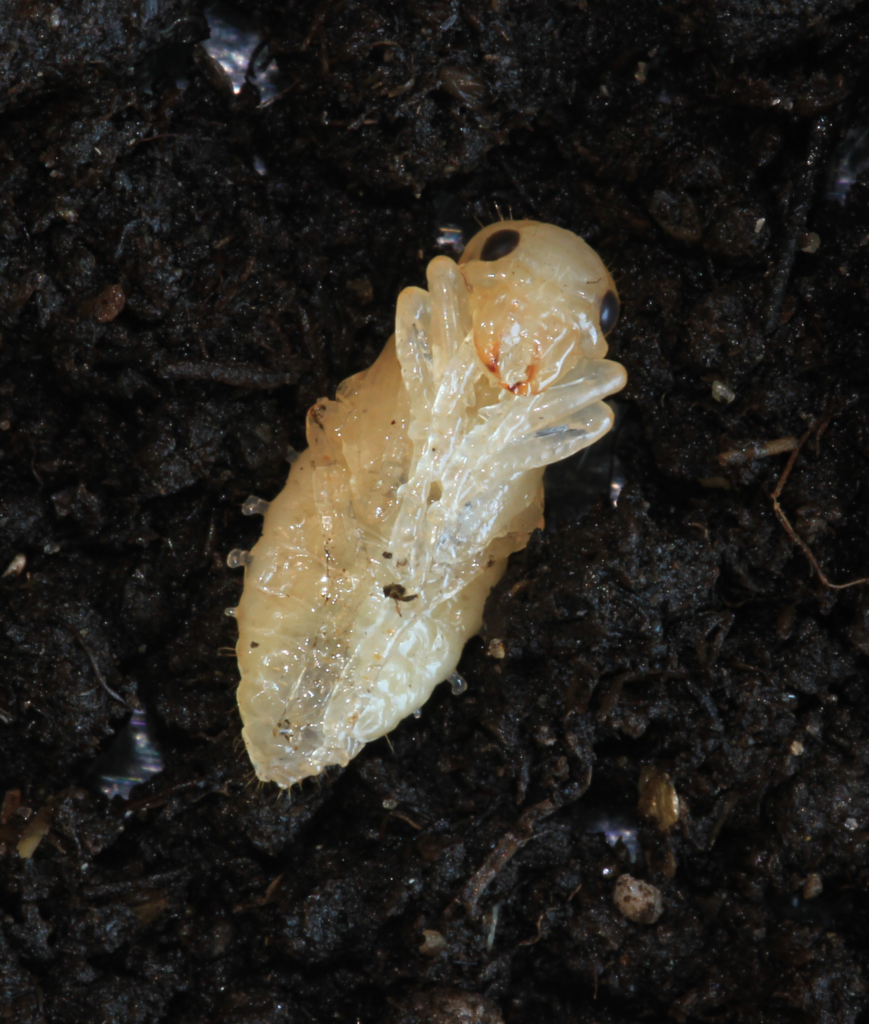All about beetles. Jump down to: Beneficial, Background • Physical description • Head, eyes, mouth, brain • Senses • Thorax, Legs, Wings • Abdomen, Respiration • Life cycle, Larvae, Pupae, Diapause, Lifespan • Habitat, Foods, Predators, Defenses
Take a good look at the photo above—is it any wonder beetles have captured the imagination of people since ancient times? They’ve appeared in paintings, sculptures, gemstones, jewelry, and coins. Ancient Egyptians based amulets on scarab beetles, which were a symbol of the sun. One of their sun gods, Khephri, has a scarab head. You may even have beetle art or jewelry yourself—perhaps the ever-popular ladybug?
Beetles are what a mythical god might be, nearly omnipresent: Step outside, and they’ll be nearby, if mostly unseen—at our feet, on shrubs and trees, around our houses, under mulch, leaves, rocks, or wood. There are some 900,000 insect species on our planet, and beetles comprise 30 percent of them, as well as about 30 percent of all other animal species!
Beetles are beneficial
Despite the bad reputation of those that damage crops and gardens, most beetles are beneficial or at least inoffensive. Ladybird beetles (popularly known as ladybugs), soldier beetles, and rove beetles are some of the predatory insects that feed on such plant pests as aphids, mealybugs, and scales. And, they incidentally help pollinate plants as they move around. Ground beetles feed on snails, cutworms, caterpillars, slugs, root maggots, and others. Many scarab beetles eat the droppings of other animals, which helps to keep our planet clean. Some species of scavenger beetles feed on mosquito larvae.
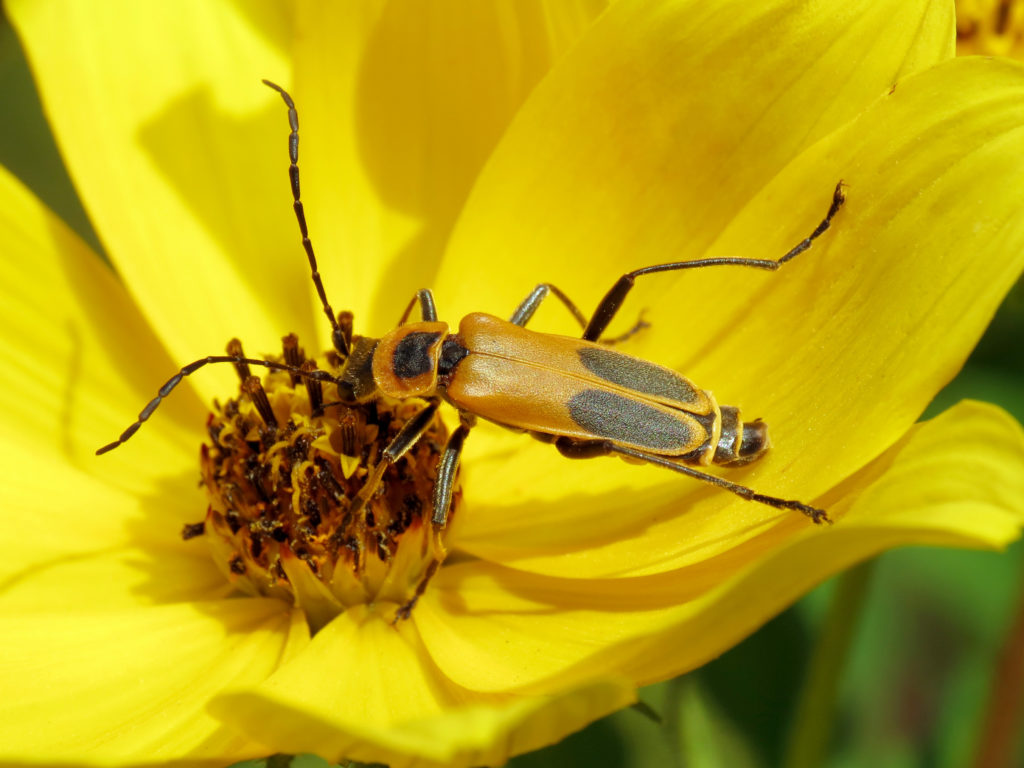
Goldenrod Soldier Beetles, Chauliognathus pensylvanicus, help pollinate milkweeds, and also include pest insects in their diet. ( Katja Schulz/Flickr; CC BY 2.0)
Background
Worldwide, there are around 350,000 known species of beetles (including weevils, a type of beetle). The only places that don’t have them are polar regions and deserts. North America alone has around 30,000 species. Impressive as these figures are, they’re merely a drop in the bucket, according to entomologists, who estimate there are five to eight million still to be discovered. New ones are found faster than taxonomists can classify them.
Beetles, along with weevils,1 are in the order Coleoptera (coal-e-OP-ter-uh), a name that comes from the Greek koleon, meaning sheath, and pteron, meaning wings. “Sheath wings” is a reference to the hardened structure of beetles’ forewings.
Based on the oldest fossil found so far, they date back at least 318 to 299 million years (late Carboniferous Period to early Permian Period), long before the age of dinosaurs. “Beetles are the most dominant, species-rich group of organisms in terrestrial ecosystems, says Max Barclay, beetle collection manager at the Natural History Museum in London. “They have divided the world up into very small pieces to specialize in their different jobs, managing to co-exist without competing with each other.”
Physical description
Beetles range in size from nearly microscopic to alarmingly large. Featherwing beetles (family Otariidae), the smallest, are only 0.01- to 0.16-inches-long (0.3 to 4.0 mm)—about a quarter the length of a grain of rice. The world’s longest (but not the heaviest) is the Titan Beetle, Titanus giganteus, a Neotropical species whose body length is 6.6 inches (16.7 cm). The top contender would appear to be the massive Hercules Beetle, Dynastes hercules, based on its overall length of 6.8 inches (17.5 cm), but half of that is the male’s horn.
Beetles, like all insects, have three body sections—head, thorax, and abdomen—and a skeleton that’s on the outside of their body, where it provides support and protection. Beetles can differ distinctly from each other in appearance, but their body shape is generally oval or elongated. Most are brown or black, but there are color variations that blaze with brilliant colors and awesome patterns. Some are among the most beautiful insects on the planet, with spectacular iridescent green-blue-violet, red, gold, or copper colors.
Head
The head contains two eyes, mouthparts, and two flexible antennae that vary in length and type, depending on the species. Antennae may be threadlike, clubbed, comb-like, toothed, angled, or resemble a string of beads.
Eyes: Their eyes are compound, which means they’re made up of hundreds of individual lenses that transmit signals via neurons to the brain for interpretation. They’re particularly adept at detecting motion, one reason it’s hard to sneak up on beetles. There’s some variation in eye size and function. Some examples: Beetles that hunt, such as ground beetles, and those that use their sight for finding mates, such as fireflies, have larger eyes. Those that swim on the surface of ponds and lakes, such as whirligig beetles, have divided eyes that give the appearance of two pairs—the top half sees above water, the lower half sees below. The Eastern Eyed Click Beetle has rather small compound eyes, but in an interesting twist, also a pair of large “false eyes” (eyespots) on its pronotum to frighten predators away.
Mouthparts: The “mouth” has no resemblance to that of a mammal. It’s made up of many parts that are collectively called mouthparts. They include mandibles (jaws) that are designed for the type of food they eat: Some are for biting off and chewing plants, and those of predatory beetles are pincer-like, adapted for grabbing and holding prey. Other notable mouthparts are palpi (PAL-pee; singular: PAL-pus), which are finger-like appendages that move food to the beetle’s mouth and also can detect smells.
Brain: Their brain doesn’t play a significant role in controlling bodily functions and mainly consists of clusters of neurons that interpret incoming sensory information. Beetles may be able to “think,” at least in some fashion. Researchers testing ground beetles in a controlled setting found they were capable of learning the best way to avoid aggressive ants by choosing from several options variously presented to them.
Labial glands, nerve ganglia, esophagus: These body parts begin in the head and extend into the thorax and abdomen. Labial glands aid in digestion and nerve ganglia supply commands to the legs and wings and interpret sensory input from the eyes. The esophagus is a simple tube that leads to the crop, where consumed food is stored.
Senses
All beetles have four senses—vision, touch, smell, taste—and at least one species can hear.
- Touch: They feel with both their antennae and sensitive body hairs, called setae (SET-ee). The antennae also detect vibrations.
- Taste and smell: Beetles taste by detecting the chemical composition of foods they sample. And their antennae are sensitive to taste and smell.
- Vision: Their compound eyes are good at detecting movement, which helps them survive, but, because their vision is fixed, they don’t see shapes very well.
- Hearing: A few species, including the Sugarcane Beetle, Eutheola humilis, have external tympanal organs on their head that work like a human’s eardrum—they detect sound vibrations.
Thorax
The thorax is the middle section of the body and has two parts. Viewed from above, they’re mostly hidden, however, and only the front part, the pronotum, can be seen. A shield-like plate, called the scutellum, is also on the top—it typically forms a small triangle-shape at the base of the wings. Attached to the thorax are three pairs of legs and two pairs of wings.
Legs
Each leg has two to five segments with one claw at the end, (sometimes two). The legs are adapted to the lifestyle of its bearer. For example, water beetles have long, flat, sometimes fringed legs for swimming. Beetles that dig have strong, wide front legs with spines or horns on them. Flea beetles have strong hind legs for jumping.
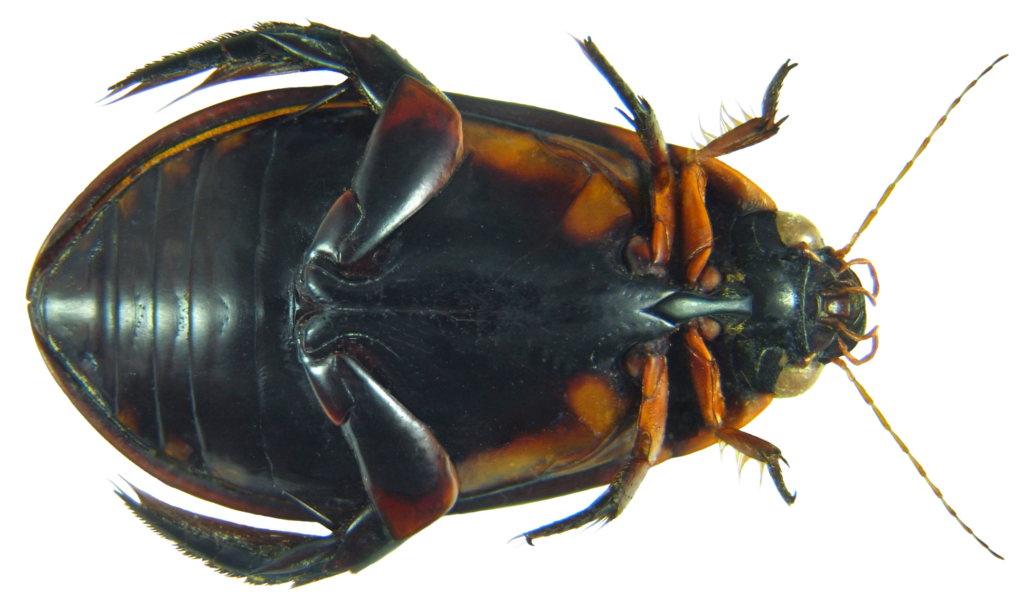
Underside of female Cybister rugosus Beetle showing the attachment of legs to thorax. (Udo Schmidt/Flickr; CC BY-SA 3.0)
Wings, elytra
Beetles have two forewings and two hind wings. The forewings, for most species, are hardened by a cross-linked protein called sclerotin. Called elytra (EL-uh-truh; singular: elytron), they protect the hind wings, which are thin and delicate, and kept folded under them when not in use.
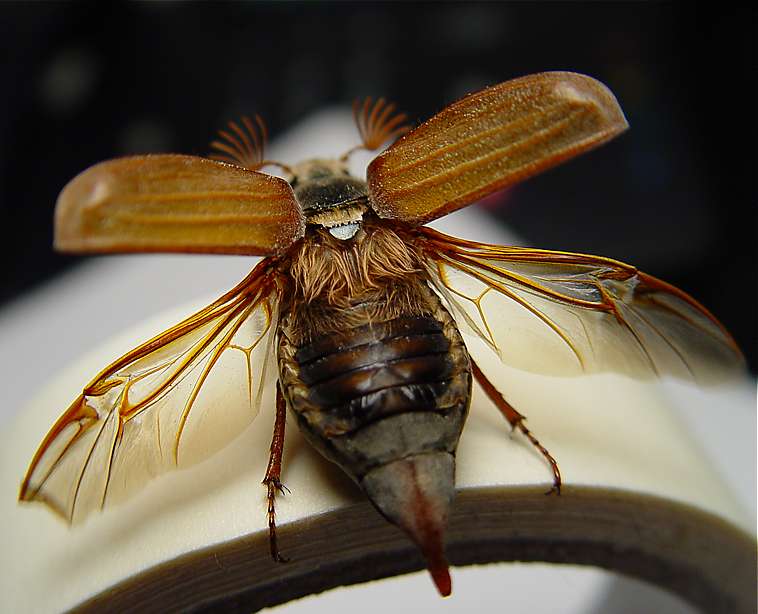
Common Cockchafer Beetle (Melolontha melolontha), displaying elytra and hind wings at take-off. (Mario Sarto / Wiki; cc by-sa 3.0)
The elytra serve other purposes, too. Their toughness allows some species to crawl into soil and yard debris or bore into trees without getting damaged. Others can trap moisture under them, which enables them to live in deserts—they carry their water supply with them. And, some can trap air under their elytra and live in water.
However, there’s a downside to them during flight, as their rigidity provides some lift, but reduces aerodynamic efficiency, They move only vertically, while the hind wings beat downward and forward. For flight, they’re raised up and out of the way (like the gull-wing doors on a 1970s DeLorean car) so that their carefully folded hind wings can spread out. (Although most beetles keep their elytra elevated during flight, but there are some groups that fold theirs over the body once the hind wings are freed.) Almost all beetles can fly. Some, like ground beetles, however, simply prefer not to, and there are a few species that lack wings, altogether.)
Abdomen
The abdomen consists of eight to nine segments. It contains the rearmost parts of the nervous, digestive, and circulatory systems, as well as the excretory and reproductive systems. It’s flooded with “blood” (in insects, called hemolymph) and has glands that produce pheromones. Sixteen pores (eight on each side of the abdomen), called spiracles, lead to thoracic tubes through which air enters and carbon dioxide exits. (The thorax also has one pair.) It’s a passive process that’s called rhythmic tracheal compression. (For more details about respiration, go here.)
Life cycle
Beetles pass through four life stages in their development—a process called complete metamorphosis: From egg to larva to pupa to adult. This progression may take as little as a few weeks or up to several years, depending on the species.
Males and females find each other through chemical odors and visual clues. They begin with a courtship, such as the male stroking the female with his antennae or legs. Beetles have sex organs, and if she accepts him, he mounts her from behind. Afterward, the male goes his own way, and the female starts her search for a place to lay her eggs. That may be on a leaf, in leaf litter, in wood cracks or rotten wood, in the ground, in feces, or other places. Carpet beetles that have found their way indoors lay their eggs in carpet, woolens, and furs.
Larvae
All beetle larvae have well-defined heads, distinct antennae, and chewing mouthparts, but otherwise may differ from each other in size and shape. They may or may not have legs, and are often grub-like. None look anything like they’ll be as adults. The long, thin, reddish-brown body of a Black Ground Beetle, for example, is very different from the black, hard-bodied adult it will become.
Larvae are eating machines—their sole job is to grow and ready themselves for pupation. The length of time spent as a larva depends on the species—for some, it’s several years. As they put on size, they periodically outgrow their exoskeleton’s ability to stretch any further, so they shed it (molt). Following their final molt, they pupate.
Pupation
Pupation is the stage where a larva transforms into an adult. It can take from days to months and is magical, comparable to the transformation of a caterpillar into a butterfly. When a beetle emerges, it’s a full-sized adult, ready to eat, mate and complete the last stage of its life. Watch a Hercules Beetle metamorphose right before your eyes
Diapause
Beetles survive freezing weather either as adults or larvae, depending on the species. For example, soldier and ladybird beetle adults bury themselves in leaf litter, plant debris, or other places that provide some insulation and enter a state of dormancy called diapause (a sort of suspended animation that isn’t hibernation). Whirligigs, which live in water, spend winter there as adults. Larvae that live in soil dig down below the freezing line.
Lifespan
Most beetles live for about a year in their adult stage, but it varies. Some, such as the Bean Beetle, Callosobruchus maculatus, live only a week or two. Water beetles live two or three years, stag beetles three to five.
Habitat
There are beetle species for every environment, but most live on land. Some spend their time on leaves, in or on flowers, or in leaf litter. Some live in rotting wood, under loose tree bark or stones. Others live in grain silos, caves, or the nests of ants, termites, birds, and mammals. Some species spend their lives in sand and seashore debris or, like whirligigs (family: Gyrinidae), in water.
Foods
Their exact food of choice depends on the species, but the majority of beetles eat plant parts—leaves, fruit, nectar, flowers, seeds, roots, or the heartwood of trees. Others feed on fungi, decomposing matter, carrion, or even dung. There are some—ladybird beetles, soldier, rove, and ground beetles among them—that prey on insects and invertebrates.
Predators and defenses
Beetles are prey for birds, amphibians, reptiles, other insects, spiders, and even other beetles. Mammals, such as shrews and bears—and in some places in the world, humans—eat them, too.
Their first line of defense is camouflage, blending into their surroundings. Another is their hard elytra, which presents a substantial barrier against other insects. Ladybird beetles and others with a dome-shaped body can even tuck their legs and antennae underneath, just like some turtles do. Some ground beetles have glands that spray formic acid, which can burn a predator’s mouth, skin, and eyes. Many brightly colored beetles taste bad, and predators learn to stay away. Some beetles mimic the coloration of distasteful ones to discourage predators. Weevils, a type of beetle, play dead!
——————————————
1 Weevils are in a superclass of their own, Curculionoidea
More reading:
In your yard: look for these ladybugs and other beetles
All about ants
All about earwigs
In your yard: crickets



